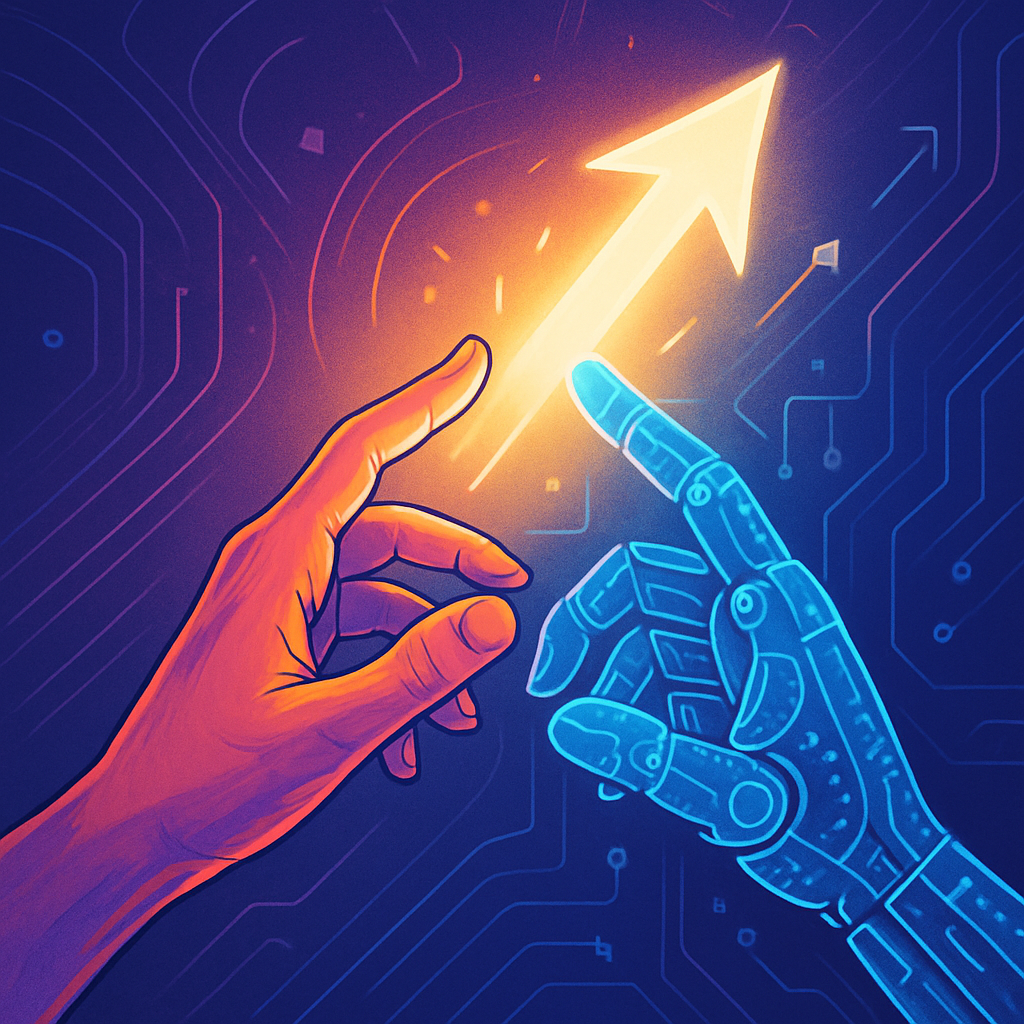
What Is Context Engineering and Why Should Your Business Care?

TL;DR - The Quick Answer
Context engineering is about giving AI systems comprehensive background information—your company data, customer history, business processes—instead of just writing perfect prompts. It's why some businesses get amazing results from AI while others struggle with robotic responses. Think of it as the difference between hiring someone who already knows your business versus someone you have to explain everything to each time.
If you've been trying to get better results from ChatGPT, Claude, or other AI tools by perfecting your prompts, you're not alone. Most business owners spend hours crafting the "perfect" instructions, hoping their AI will finally understand what they need.
But here's what successful businesses have discovered: the secret isn't in the prompt—it's in the context.
Tobi Lütke, CEO of Shopify, put it perfectly: "I really like the term 'context engineering' over prompt engineering. It describes the core skill better: the art of providing all the context for the task to be plausibly solvable by the LLM."
This shift from prompt engineering to context engineering is transforming how businesses use AI. Instead of trying to write magical sentences that make AI understand you, context engineering builds systems that automatically provide AI with everything it needs to know about your business, customers, and goals.
What Exactly Is Context Engineering?
Context engineering is the practice of designing systems that give AI comprehensive background information before it tries to help you. Instead of starting from scratch with each conversation, your AI has access to:
- Your company's policies and procedures
- Customer interaction history
- Current business data and metrics
- Your specific industry knowledge
- Past successful solutions and outcomes
As AI researcher Andrej Karpathy explains, context engineering is "the delicate art and science of filling the context window with just the right information for the next step."
Think of it this way: prompt engineering is like giving detailed instructions to someone who's never worked at your company. Context engineering is like having a knowledgeable employee who already understands your business and just needs to know what specific task to tackle today.
Why Context Engineering Matters More Than Perfect Prompts
The reason context engineering is gaining traction among business leaders is simple: it works better for real business scenarios.
Traditional Prompt Approach:
"You are a customer service representative for our software company. Be helpful and professional. A customer is asking about refunds..."
Context Engineering Approach:
Your AI automatically knows:
- The customer's purchase history and previous interactions
- Your company's current refund policy and any recent changes
- Similar cases and how they were resolved successfully
- The customer's subscription tier and special considerations
- Current system status and known issues
The difference in results is dramatic. The first approach might work for simple questions, but it breaks down when customers reference past conversations, need personalized solutions, or present complex scenarios your prompt didn't anticipate.
Context engineering handles these real-world complexities naturally because the AI has comprehensive background knowledge, just like your best human employees would.
Synaptic Labs AI education attribution requiredThe Four Ways Context Engineering Transforms Business AI
Research from LangChain identifies four key strategies that make context engineering so effective for business applications:
1. Writing Context (Building Business Memory)
Your AI systems can now "remember" important information between conversations:
- Customer preferences and interaction history
- Successful solution patterns for common problems
- Company policy updates and procedural changes
- Performance metrics and business insights
2. Selecting Context (Smart Information Retrieval)
When a customer or employee asks a question, the system automatically finds and includes relevant background information:
- Related documentation and knowledge base articles
- Similar past cases and their solutions
- Current business data and real-time information
- Relevant team members and their expertise areas
3. Compressing Context (Efficient Information Management)
As interactions grow longer, the system intelligently summarizes and prioritizes information:
- Key decisions and outcomes from lengthy discussions
- Essential customer information without overwhelming detail
- Important business changes and their implications
- Patterns and insights from multiple interactions
4. Isolating Context (Focused Task Management)
Complex business processes get broken into focused steps, each with optimized information:
- Different information sets for different team members
- Task-specific knowledge for various business processes
- Appropriate access levels based on roles and responsibilities
- Specialized contexts for different business functions
Real Business Benefits You Can Expect
When businesses implement context engineering properly, they see immediate improvements:
Better Customer Service: AI knows customer history, previous issues, and successful solutions without agents having to search through multiple systems.
More Accurate Responses: Instead of generic answers, AI provides solutions based on your specific business policies, procedures, and past successful outcomes.
Reduced Training Time: New team members get AI assistance that already understands your business, reducing the learning curve significantly.
Consistent Quality: AI maintains consistent service quality because it has access to your best practices and successful solution patterns.
Scalable Expertise: Your AI systems can apply your top performers' knowledge across all customer interactions and business processes.
Context Blocks: Your Foundation for Success
The practical implementation of context engineering starts with something called "context blocks"—modular information containers that you can systematically combine for different business needs.
Instead of writing lengthy prompts that try to cover everything, you create focused information blocks:
- Company Identity Block: Your mission, values, and key business information
- Customer Context Block: Individual customer data, preferences, and interaction history
- Process Guidance Block: Step-by-step procedures for common business tasks
- Knowledge Access Block: Relevant documents, policies, and reference materials
These blocks can be mixed and matched automatically based on the specific situation, ensuring your AI always has the right information without information overload.
Getting Started: Simple Steps for Your Business
You don't need to revolutionize your entire AI setup overnight. Here's how to begin implementing context engineering in your business:
Start Small: Pick one specific business process—like customer onboarding or support ticket handling—and focus on building better context for that single use case.
Gather Your Information: Collect the documents, procedures, and knowledge that your best employees use for this process. This becomes your context foundation.
Create Context Blocks: Organize this information into clear, focused blocks that can be automatically provided to AI when relevant.
Test and Refine: Start using your context-enhanced AI for the chosen process and refine based on results and team feedback.
Expand Gradually: Once you see success with one process, apply the same approach to other business areas.
Your Context Engineering Companion
Building effective context engineering systems requires understanding which information to include, how to organize it, and when to provide it. This is where having expert guidance becomes invaluable.
That's why we created the Context Engineer bot—your specialized AI assistant for building better business context systems.
The Context Engineer bot can help you:
- Analyze your current business processes and identify context opportunities
- Design information architecture that scales with your business growth
- Create context blocks that improve AI performance for your specific industry
- Troubleshoot context engineering challenges with actionable solutions
- Optimize information flow for maximum business impact
Whether you're just starting with business AI or looking to upgrade existing systems, the Context Engineer bot provides expert guidance tailored to your specific business needs.
Access the Context Engineer Bot Now →
The Future Is Context-Aware Business AI
Context engineering represents a fundamental shift in how businesses approach AI implementation. We're moving from hoping AI will understand us to systematically ensuring it does.
The businesses that embrace this shift early are already seeing significant competitive advantages. Their AI systems provide more helpful, accurate, and personalized responses because they operate with comprehensive business knowledge rather than generic instructions.
Your context engineering journey can start today with simple improvements to how you provide information to your AI systems. Small changes in context can produce dramatic improvements in AI effectiveness.
Ready to transform your business AI with context engineering? Visit our Context Engineer bot and start building AI systems that truly understand your business.
Frequently Asked Questions
Q: How is context engineering different from just writing better prompts?
A: Prompt engineering focuses on crafting perfect instructions for each interaction. Context engineering builds systems that automatically provide AI with comprehensive background information—your business data, customer history, and relevant knowledge—before any specific task. It's the difference between explaining your entire business every time versus having an AI that already knows your company.
Q: Do I need technical expertise to implement context engineering?
A: While advanced implementations require technical knowledge, business owners can start with simple context improvements using existing tools. The key is systematically organizing your business information so AI can access it when needed. Our Context Engineer bot can guide you through practical first steps that don't require coding.
Q: Will context engineering work with the AI tools I'm already using?
A: Yes! Context engineering principles apply to ChatGPT, Claude, and other AI platforms. You can improve results immediately by providing better background information and organizing your business knowledge more systematically. More advanced implementations might involve specialized tools, but you can see benefits right away.
Q: How do I know if my business needs context engineering?
A: If your AI gives generic responses, doesn't remember previous conversations, or requires you to re-explain your business context repeatedly, you'll benefit from context engineering. Most businesses using AI for customer service, content creation, or operational support see immediate improvements.
Q: What's the biggest mistake businesses make with AI context?
A: Providing too much irrelevant information or too little relevant information. Context engineering is about finding the right balance—giving AI everything it needs to understand your specific situation without overwhelming it with unnecessary details. This balance improves with systematic testing and refinement.
Q: How long does it take to see results from context engineering?
A: Simple context improvements can show results immediately—like providing your AI with company policies or customer information. More sophisticated systems might take weeks to implement, but most businesses see meaningful improvements in AI performance within the first few implementations.


